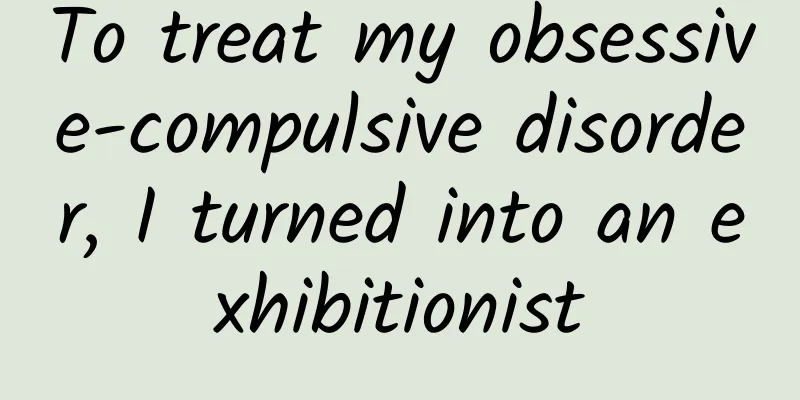To treat my obsessive-compulsive disorder, I turned into an exhibitionist

|
Are you shocked by the title? The "exposure" mentioned here does not refer to the "perverted" way of taking off clothes in public, but the method used in psychotherapy to treat obsessive-compulsive disorder. "Exposure" is actually a kind of "experience". Actively putting yourself in a situation that you fear and worry about feels like being exposed to extreme danger without any preparation... Once you realize that "it's actually no big deal", your anxiety and fear will be greatly reduced. As a psychotherapist, I often encounter the following situations in clinical practice: Patient 1: "Doctor, people on the Internet say to let nature take its course, accept yourself, and not to worry about obsessive-compulsive symptoms. I think that makes sense. But it only seemed to be somewhat helpful at the time. After a while, I still feel entangled. Is it because my condition is more serious, or is my willpower not strong enough?" Patient 2: "Some doctors told me that the more afraid I am, the more I have to face it, and exposure is the most effective. But I am afraid. When I hear about exposure, I am still scared. After trying it once, I dare not continue the treatment at all!" Cognitive behavioral therapy, including exposure and response prevention (ERP), is currently the first-line recommended treatment for obsessive-compulsive disorder. Many people understand that if they want to overcome symptoms, they must face and expose themselves. However, I understand the reason, but I just can't do it. Studies have shown that 30% of patients will stop treatment due to fear and terror if the exposure is carried out directly. In order to prevent people from running away from the treatment, the exposure should be planned and organized, which can be called "treatment". Direct exposure like the above example is an unplanned "exposure" and mental torture, which will make the patients lose confidence. So, how can we expose the virus in a planned and organized manner? Why are recurring obsessive-compulsive disorder so stubborn? -Understanding the psychological mechanisms of obsessive-compulsive disorder symptoms- For example: A patient with an excessive need for cleanliness, when faced with a situation of throwing away garbage (inducing situation), worries that he will touch the trash can (intrusive thoughts), and that the trash can is very dirty and has a lot of bacteria and viruses on it, which will cause him to be infected with a serious disease and then die (catastrophic thoughts), followed by emotional reactions such as tension, dizziness, and rapid breathing (anxiety). Instinctively, patients will try to relieve their anxiety and find what they think is the most "effective" method - when throwing away the garbage, they repeatedly observe the distance between their hands and the trash can, and after throwing away the garbage, they repeatedly wash their hands to achieve the purpose of "cleanliness" (compulsive behavior). After repeatedly confirming and washing their hands, the patient feels relieved and unprecedentedly relaxed (anxiety relief). Compulsive behavior is like an infinite loop. If you don’t break out of this loop, it’s hard to really solve the problem | pixabay In fact, compulsive behaviors like this only temporarily relieve anxiety, but in the long run they maintain compulsive symptoms. Over time, compulsive behaviors will slowly become an "addiction" behavior, and its psychological mechanism is similar to smoking and drinking. Many people who smoke and drink know that doing so will affect their health, but they just can't control themselves. Compared with healthy methods such as exercise, smoking and drinking are more effective in relieving anxiety, and are simpler, faster and more convenient to operate. It is very difficult to quit such addictive behaviors. After forming such a "habit", when encountering a similar situation again, obsessive thoughts will reappear uncontrollably, and then anxiety will arise; adhering to the principle of convenience, compulsive behavior will be used habitually to relieve anxiety... Over and over again, falling into an infinite cycle. The following figure clearly shows this process: The cognitive theory model of obsessive-compulsive disorder, with the red part being the focus of treatment | Provided by the author How to effectively resolve the cycle of compulsion? - Grasp the key points of treatment - In theory, it seems that this cycle can be broken by weakening any link. However, the reality is cruel. A large number of studies have proved that intervening in "inciting situations" or "intrusive thoughts" is useless. There are many kinds of "inciting situations" and we cannot control all of them. For example, patients who are afraid of dirt can ensure cleanliness at home, but cannot ensure cleanliness in public places. From the perspective of modern neurobiology, "intrusive thoughts" are caused by the normal activity of brain neurons. Everyone has a large number of intrusive thoughts every day, which is uncontrollable. When you want to control and suppress such thoughts, it often backfires and makes the thoughts more profound. Image | pixabay Since everyone experiences intrusive thoughts, why do people with OCD struggle with them more than others? For example, when you see a money truck, you may suddenly have the urge to do something; when you stand on the roof, you may suddenly have the urge to jump off... But after leaving this scene, you will think: I was just thinking about it, how could I really do it? Then you will not dwell on it. But patients with obsessive-compulsive disorder will imagine more scenes: "Ah! Robbing a money transporter is too dangerous. The security guards have guns and will definitely shoot me on the spot, or arrest me and put me in prison for more than ten years. I will never be able to hold my head up again in my life." Then they will mistakenly believe that they are really going to do such a thing, worry that they will lose control, and be particularly afraid; even after a few days, they are still thinking about this idea. People with obsessive-compulsive disorder may imagine more images | pixabay Mistaking the most terrible imagined outcomes as reality or a destined future - this is catastrophic thinking, an important cause of anxiety for patients with obsessive-compulsive disorder, and the beginning of a vicious cycle. Therefore, the key to intervening in obsessive-compulsive disorder is neither to change the environment nor to try desperately to control one's own thoughts, but to correct "catastrophic thoughts", relieve "anxiety" emotions, and replace "compulsive behaviors." Research shows that the conventional cognitive behavioral therapy methods of correcting "catastrophic thinking" and various methods of relieving "anxiety" such as relaxation, acceptance, and mindfulness are effective, but the results are not ideal. The most effective method is exposure. What exactly is exposure? -Understanding the principles of exposure- The principle of exposure is habitual decay. Our anxiety will not remain at a very high level all the time, but will gradually stabilize over time, or even ease on its own. As the ancients described, "If you enter a shop selling abalone, you will not smell its stench for a long time; if you enter a room selling orchids, you will not smell its fragrance for a long time." Exposure is actually to prove that catastrophic thinking is wrong. It relieves anxiety by facing it directly and not using compulsive behavior. The patient only needs to stay in anxiety until the anxiety decreases significantly. Using the body to feel compulsive behavior is not the only way to relieve anxiety. Emotional curve of exposure: As the number of successful exposures increases, the degree of anxiety pain continues to decrease, and the speed of anxiety relief gradually increases; on the contrary, if you use the "escape" method to avoid the feared thing, the more times you do it, the higher the degree of anxiety pain will continue to increase. | Provided by the author Through continuous practice, anxious emotions will become easier and easier to relieve, which will in turn prompt the patient to question the rationality of catastrophic thoughts and eventually form the habit of facing anxiety through exposure, replacing compulsive behaviors and breaking the vicious circle. Set measurable goals - Specific content of exposure - What patients with obsessive-compulsive disorder fear is not the specific triggering situations or intrusive thoughts, but the images behind the obsessive thoughts, that is, catastrophic thoughts. Symptoms that seem to be the same may have completely different reasons. For example: A: I am afraid of dirt. I think dirt will bring bad luck, so I wash my hands frequently. B: They are afraid of dirt, thinking that dirt may infect them with diseases or even infect others, so they wash their hands frequently. The fears in these two examples are actually different, so the exposure tasks are also different - the former exposes luck issues, and the latter exposes hygiene issues. In addition, exposure needs to be carried out step by step, and is divided into 10 levels from high to low according to the degree of pain caused by emotions. The following is the exposure level table for a patient who compulsively washes his hands: Figure | provided by the author After the levels are divided, the psychotherapist will advise the patient to start from the level with a low degree of pain, and then transition to the next level after "getting used to" this type of stimulation, challenging it step by step, just like climbing stairs. The advantage of doing this is that challenges are more likely to succeed and confidence is easier to build. If you challenge the highest level task at the beginning, you will most likely fail. This is the most classic unplanned "exposure" of forcing yourself to do it. If you fail in the first battle, the patient's confidence will often be greatly hit, and he or she may even become more afraid. It is important to note that you should not diagnose and treat obsessive-compulsive disorder on your own. All treatments should be carried out with the help of a psychotherapist. A regular psychotherapist can help you develop a reasonable and practical plan. If you are not sure whether you have obsessive-compulsive disorder, it is recommended that you go to a psychiatric or psychological hospital for evaluation and diagnosis. Do not diagnose and treat yourself. If you have been diagnosed with obsessive-compulsive disorder, please discuss with your doctor what kind of treatment you should receive. Both medication and psychotherapy may be of great benefit to you. Image | pixabay References 1. Xu Qi, Zhu Yawen, Yu Meng, et al. A case report of cognitive behavioral case conceptualization consultation for obsessive-compulsive disorder[J]. Chinese Journal of Mental Health, 2018, 032(003):207-214. 2. Salkovskis PM. Psychological treatment of obsessive–compulsive disorder[J]. Psychiatry, 2007, 6(6):229-233. 3. Yan Jun, Li Lingjiang, Ji Jianlin, et al. Overview of diagnosis and treatment of obsessive-compulsive disorder[J]. Chinese Journal of Mental Health, 2014, 028(004):308-320. 4. Cognitive behavioral treatments of obsessive–compulsive disorder. A systematic review and meta-analysis of studies published 1993–2014[J]. Clinical Psychology Review, 2015, 40:156-169. 5. Himle MB, Franklin ME. The More You Do It, the Easier It Gets: Exposure and Response Prevention for OCD[J]. cognitive & behavioral practice, 2009, 16(1):29-39. 6. Barlow. A unified approach to transdiagnostic treatment of mood disorders: A self-help manual[M]. China Light Industry Press, 2013. 7. Michael J. Kosar, Edna B. Foa. Overcoming Obsessive-Compulsive Disorder: A Therapist's Guide/Self-Help Manual[M]. China Renmin University Press, 2010. 8. Koran LM, Hanna GL, Hollander E, et al. Practice Guideline for the Treatment of Patients with Obsessive–Compulsive Disorder[J]. American Journal of Psychiatry, 2007, 164(7 Suppl):5-53. Author: Old Gu who loves science Editor: Yakumo This article comes from Guokr and may not be reproduced without permission. If necessary, please contact [email protected] |
<<: What is the value of red okra? How to choose red okra
>>: Stay away from "mouse hand", don't miss these methods
Recommend
At what age should children with crooked teeth be corrected? Let’s take a look at the “golden timetable” for orthodontics
In an environment that focuses on "appearanc...
Homemade lotion
With the rapid development of modernization, peop...
The impact of humidity on breast milk
Many women who are breastfeeding have heavy moist...
Can towels and bed sheets in hotels really transmit “that disease”?
One minute with the doctor, the postures keep cha...
What is the cultural connotation of the Dragon Boat Festival? What are the special dishes of the Dragon Boat Festival?
The Dragon Boat Festival generally refers to the ...
Can I get pregnant if I have sex on the 16th day after my period ends?
Many women ask how many days after menstruation t...
Causes of breast milk leakage
Many female friends may not be so clear about the...
How to reverse menopause at the age of 42
Many female friends have amenorrhea. There are ma...
Prevention and treatment of hand, foot and mouth disease in children
Etiology of hand, foot and mouth disease in child...
Flurry: Survey shows Android guys are more romantic than iPhone guys?
Valentine's Day has just passed, and there sh...
Gynecological medicine to remove odor
After entering spring, with the temperature risin...
Is it normal for pregnant women to have swollen and painful breasts in early pregnancy?
In the early stages of pregnancy, breast pain is ...
Will the amount of vaginal discharge increase during the first week of pregnancy?
Pregnancy is a process that many women will go th...
One month of pregnancy with some bleeding
For those who have just become pregnant, you may ...









